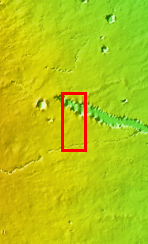
Context image
Credit: NASA/JPL/MOLAThis VIS image shows two different types of linear depressions. The wide depression at the top of the frame is Elysium Fossae, which most likely formed due to tectonic activity. The fossae is probably bounded on both sides by faults. The narrow depression at the bottom of the frame is a lava channel called Patapsco Vallis. This channel has lava flows on both sides which were probably formed by over spilling of lava as it flowed down the channel. Both these features are located east of Elysium Mons.
Image information: VIS instrument. Latitude 24.1N, Longitude 152.8E. 21 meter/pixel resolution.
Please see the THEMIS Data Citation Note for details on crediting THEMIS images.
Note: this THEMIS visual image has not been radiometrically nor geometrically calibrated for this preliminary release. An empirical correction has been performed to remove instrumental effects. A linear shift has been applied in the cross-track and down-track direction to approximate spacecraft and planetary motion. Fully calibrated and geometrically projected images will be released through the Planetary Data System in accordance with Project policies at a later time.
NASA's Jet Propulsion Laboratory manages the 2001 Mars Odyssey mission for NASA's Office of Space Science, Washington, D.C. The Thermal Emission Imaging System (THEMIS) was developed by Arizona State University, Tempe, in collaboration with Raytheon Santa Barbara Remote Sensing. The THEMIS investigation is led by Dr. Philip Christensen at Arizona State University. Lockheed Martin Astronautics, Denver, is the prime contractor for the Odyssey project, and developed and built the orbiter. Mission operations are conducted jointly from Lockheed Martin and from JPL, a division of the California Institute of Technology in Pasadena.

